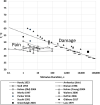Time-temperature Thresholds and Safety Factors for Thermal Hazards from Radiofrequency Energy above 6 GHz
- PMID: 34261892
- PMCID: PMC8300848
- DOI: 10.1097/HP.0000000000001447
Time-temperature Thresholds and Safety Factors for Thermal Hazards from Radiofrequency Energy above 6 GHz
Abstract
Two major sets of exposure limits for radiofrequency (RF) radiation, those of the International Commission on Nonionizing Radiation Protection (ICNIRP 2020) and the Institute of Electrical and Electronics Engineers (IEEE C95.1-2019), have recently been revised and updated with significant changes in limits above 6 GHz through the millimeter wave (mm-wave) band (30-300 GHz). This review compares available data on thermal damage and pain from exposure to RF energy above 6 GHz with corresponding data from infrared energy and other heat sources and estimates safety factors that are incorporated in the IEEE and ICNIRP RF exposure limits. The benchmarks for damage are the same as used in ICNIRP IR limits: minimal epithelial damage to cornea and first-degree burn (erythema in skin observable within 48 h after exposure). The data suggest that limiting thermal hazard to skin is cutaneous pain for exposure durations less than ≈20 min and thermal damage for longer exposures. Limitations on available data and thermal models are noted. However, data on RF and IR thermal damage and pain thresholds show that exposures far above current ICNIRP and IEEE limits would be required to produce thermally hazardous effects. This review focuses exclusively on thermal hazards from RF exposures above 6 GHz to skin and the cornea, which are the most exposed tissues in the considered frequency range.
Copyright © 2021 The Author(s). Published by Wolters Kluwer Health, Inc. on behalf of the Health Physics Society.
Conflict of interest statement
The authors declare no conflicts of interest.
Figures



References
-
- Alekseev SI, Ziskin MC. Biological effects of millimeter and submillimeter waves. Biological and medical aspects of electromagnetic fields. In: Greenebaum B, Barnes F, eds. Boca Raton, FL: CRC Press; 2019: 179–241.
-
- Bakkers M, Faber CG, Peters MJH, Reulen JPH, Franssen H, Fischer TZ, Merkies ISJ. Temperature threshold testing: a systematic review. J Peripher Nerv Syst 18:7–18; 2013. - PubMed
-
- Beuerman RW, Tanelian DL. Corneal pain evoked by thermal stimulation. Pain 7:1–14; 1979. - PubMed
-
- Brodell D, Mostow EN. Automobile seat heater-induced erythema Ab Igne. Arch Dermatol 148:264–265; 2012. - PubMed
-
- Chalfin S, D’Andrea JA, Comeau PD, Belt ME, Hatcher DJ. Millimeter wave absorption in the nonhuman primate eye at 35 GHz and 94 GHz. Health Phys 83:83–90; 2002. - PubMed
Publication types
MeSH terms
LinkOut - more resources
Full Text Sources

